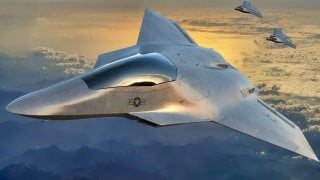Boeing Could Build the NGAD 6th Generation Fighter
Boeing, despite recent challenges, stands a chance at securing the Next Generation Air Defense (NGAD) project from the U.S. Air Force, potentially edging out competitor Lockheed Martin.
Summary: Boeing, despite recent challenges, stands a chance at securing the Next Generation Air Defense (NGAD) project from the U.S. Air Force, potentially edging out competitor Lockheed Martin. The NGAD program, shrouded in secrecy, aims to develop a sixth-generation fighter jet, the Penetrating Counter Air (PCA), alongside an unmanned system, the Collaborative Combat Aircraft (CCA). The PCA is anticipated to boast advanced digital capabilities, propulsion technology, and enhanced weaponry. Boeing's recent struggles, including the 737 MAX crisis and other safety incidents, have tarnished its reputation. However, the company's extensive experience in military aircraft development and its strong political connections might help it secure the NGAD contract, suggesting a potential comeback in military aviation.
Boeing's Bid for Redemption: Competing for the NGAD Contract
Boeing has a storied history, but a variety of mishaps cast doubt on the company’s contemporary quality. Still, there is an argument for why Boeing might win the Next Generation Air Defense (NGAD) project, the lucrative contract to field the U.S. Air Force’s sixth-generation fighter.
How can Boeing pull an upset over rival Lockheed Martin to develop the NGAD?
What is NGAD?
Confirmed details surrounding the NGAD remain scarce, but the program will feature a fighter jet, the Penetrating Counter Air (PCA), and a complementary unmanned system known as Collaborative Combat Aircraft (CCA).
A number of aerospace manufacturers will likely earn the various contracts related to the NGAD — the PCA’s airframe, engine, and avionics will be awarded separately, as will the CCA. But the contract for the PCA’s airframe fuels the most speculation. Certainly a sixth-generation airframe will be more advanced than its fifth-generation predecessor, but again, details about the PCA’s airframe require some guesswork. The jet will probably feature advanced digital capabilities, human-systems integration, variable-cycle engines, and stand-off and beyond-visual-range weapons with increased range.
In particular, the NGAD is expected to feature technological advancements relating to propulsion, uncrewed systems, materials, and sensors.
Troubles at Boeing
For Boeing to win a lucrative military contract right now would be unexpected. Boeing’s stock has been in decline for several years — literally and figuratively. The company’s troubles began with its faulty Maneuvering Characteristics Augmentation System, or MCAS.
The MCAS was an automated flight-stabilizing feature found on the Boeing 737 MAX. Because the 737 MAX had a natural attitude that pushed the nose upward, increasing the risk of a stall, Boeing included an automated system designed to sense the jet’s upward drift and correct with a downward push. (This push was just an upward tilt of the elevators, or horizontal stabilizers, which pushed the nose back down.)
The problem with the MCAS, as two commercial airliner crashes demonstrated, was bad code. During the two crashes in question, the MCAS engaged, and it could not be disengaged while the 737 MAX was in stable flight. Said another way, after the MCAS pushed the nose of the aircraft downward, it could not get the nose pointed straight and level again. In both cases, the jets nose-dived into the ground. No one survived.
More recently, a door plug on a Boeing aircraft leaving Portland International Airport blew off the fuselage, leaving a gaping hole in the aircraft that required an emergency landing. No one was physically injured, but the terrifying event further damaged confidence in the beleaguered Boeing.
But accidents tend to inspire an enhanced focus on safety. Perhaps Boeing, coming off of the bad press and costly lawsuits, will tighten their standards and find a way back to the standard of quality the company was once revered for.
Boeing is politically connected and boasts a long history of winning government contracts. The company is responsible for dozens of venerable military aircraft, including the F-15E Strike Eagle, C-17 Globemaster III, P-8 Poseidon, AH-64 Apache, and B-52 Stratofortress. Given Boeing’s demonstrated history of successful military aircraft development, they cannot be ruled out of the running for the NGAD contract.
About the Author: Harrison Kass
Harrison Kass is a defense and national security writer with over 1,000 total pieces on issues involving global affairs. An attorney, pilot, guitarist, and minor pro hockey player, Harrison joined the US Air Force as a Pilot Trainee but was medically discharged. Harrison holds a BA from Lake Forest College, a JD from the University of Oregon, and an MA from New York University. Harrison listens to Dokken.


